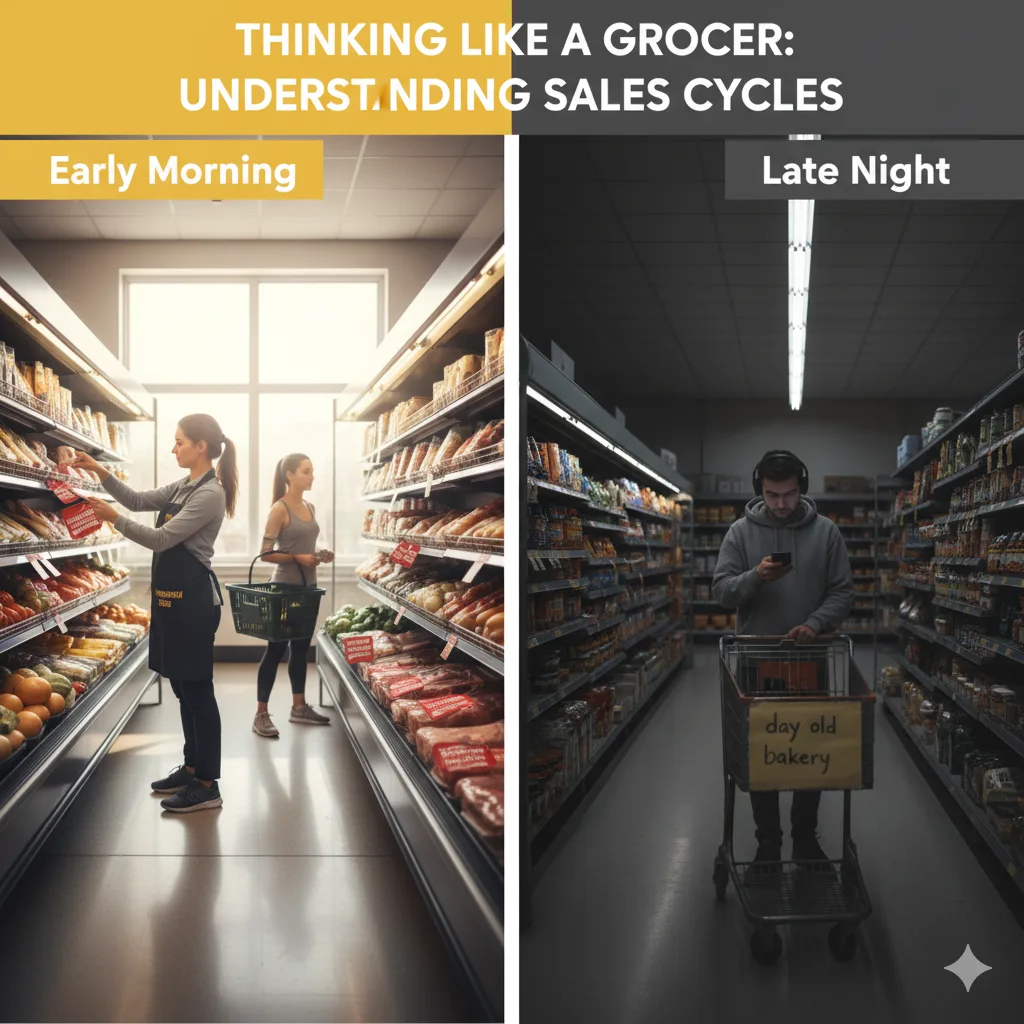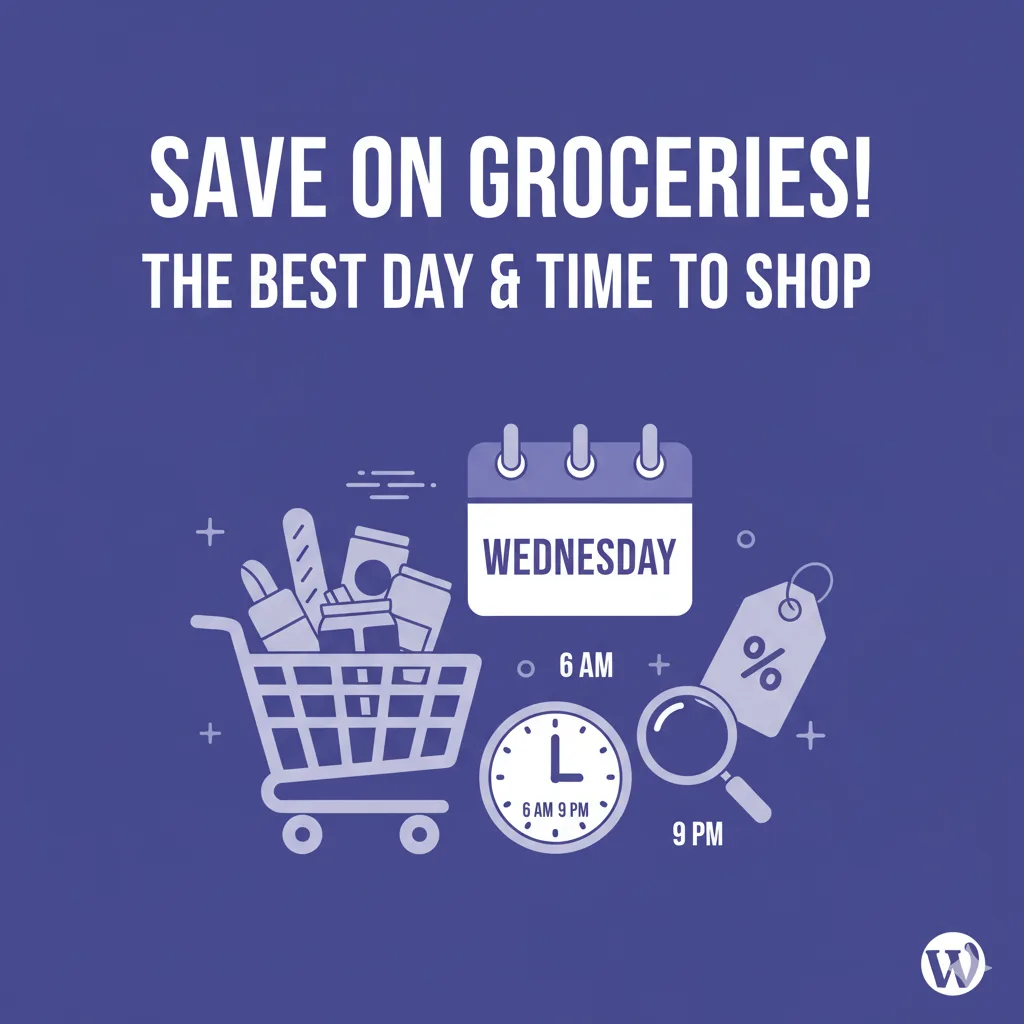Stop Overpaying at the Supermarket. Here’s the Secret Timing to Unlock Serious Savings on Your Grocery Bill.
Let’s be honest: that feeling of dread at the grocery checkout is becoming way too common. You walk in with a budget, a carefully planned list, and the best intentions. You walk out an hour later with a receipt that makes you wince, wondering how a few bags of food could possibly cost that much. It feels like the game is rigged, and no matter how carefully you plan, the bill just keeps creeping up. The truth is, grocery stores are designed to get you to spend more. But what they don’t advertise is that their entire operation runs on a predictable weekly rhythm. And if you learn that rhythm, you can stop playing their game and start winning your own.
I learned this the hard way. For years, my go-to was a chaotic Saturday afternoon trip. I’d battle the crowds, grab whatever was left on the shelves, and always leave feeling stressed and over budget. My “aha!” moment came when I had to do a last-minute shop on a quiet Wednesday morning. The store was calm, the shelves were packed, and I noticed bright orange discount stickers on things I actually needed. My bill was shockingly low. That’s when I realized the secret isn’t just what you buy, but when you buy it. Finding the best day to buy groceries is about hitting a trifecta: catching the peak sales, snagging fresh markdowns, and doing it all without the soul-crushing crowds.
The Midweek Sweet Spot: Why Wednesday Is the Champion
If you remember one thing from this article, make it this: shop on Wednesday. Across the board, experts and seasoned budget shoppers agree that Wednesday is the golden day for groceries. It’s the day when all the money-saving forces align. First, it’s when most supermarkets release their new weekly ads and digital coupons. By shopping on Wednesday, you get the first pick of all the new sale items before they get cleared out by the weekend rush. But the real insider secret is the “deal overlap.” Many stores will still honor the previous week’s sales on Wednesday as they transition, giving you a magic window where you can access two weeks’ worth of deals at once. On top of that, stores use Monday and Tuesday to restock after the weekend chaos, so by Wednesday, you’ll find fully stocked shelves and the freshest produce.

The Two Golden Hours: Early Morning vs. Late Night
Even on the best day, the time you shop can make a huge difference. There are two prime windows, each with its own advantages. The early bird slot, roughly between 6 AM and 9 AM, is prime time for hunting “manager’s special” markdowns. This is when department managers take stock of perishable items like meat, dairy, and bakery goods that are nearing their sell-by date and slap on those beautiful 30-50% off stickers. Shopping early gives you the first shot at these high-value deals. On the other hand, the night owl window, usually after 8 PM, offers a second wave of markdowns on things like rotisserie chickens and day-old bread. The biggest perk of late-night shopping, however, is the serenity. An empty store means no distractions, no long lines, and no stress, which helps you stick to your list and avoid costly impulse buys.
| Your Goal | Best Time to Shop | Worst Time to Shop |
| Lowest Prices & New Sales | Wednesday Morning | Sunday Afternoon |
| Best Selection & Fresh Stock | Weekday Mornings (Tue/Wed) | Weekend Afternoons |
| Fewest Crowds | Early Weekday Mornings / Late Evenings | Saturday Midday |
| Best Perishable Markdowns | Early Mornings (First Wave) | Midday / After Work |
The Ultimate Hack: Go to the Source and Just Ask
While these general rules are fantastic, the single most powerful strategy is to get intel specific to your local store. Every store has a slightly different schedule, and the only way to know for sure is to ask the people who run it. Don’t be shy. The department managers in the meat, produce, and bakery sections are your best source of information. Next time you’re in, just walk up and say something like, “Hi, I’m trying to plan my shopping to catch the best deals. Do you have a specific day or time when you usually mark down meat?” They are often happy to tell you, since it helps them move products. I did this at my local store and learned their butcher does all the meat markdowns first thing on Tuesday mornings. That one conversation now saves me money every single week. It’s a five-second question that can pay off for years.

Thinking Like a Grocer: Understanding Sales Cycles
Ready to level up? It’s time to stop thinking week-to-week and start planning your shopping based on grocery store sale cycles. These are the predictable patterns stores use for their big promotions, and once you see them, you can’t unsee them. Most non-perishable pantry items, such as cereal, pasta, coffee, and canned goods, go on a deep discount every 4 to 6 weeks. The goal is to buy enough of that item when it hits its rock-bottom price to last you until the next sale cycle. This is how you stop paying full price for staples, ever again. Sales are also tied to seasons and holidays. Think diet foods in January, grilling supplies for Memorial Day, back-to-school snacks in August, and baking ingredients before Thanksgiving and Christmas. Learning this rhythm shifts your mindset from “I’m out of pasta, I need to go shopping” to “Pasta is at its cheapest price this month, I will stock up.” This proactive approach is the key to serious, long-term savings.
The Worst Times to Shop (For Your Wallet and Your Sanity)
Just as important as knowing when to go is knowing when not to go. Avoid the grocery store on weekends at all costs, especially Saturday and Sunday afternoons. This is peak chaos. The aisles are jammed, the shelves are picked over, the lines are a mile long, and the stressful environment is a recipe for impulse buys that wreck your budget. The weekday after-work rush hour, from 4 PM to 6 PM, is nearly as bad. You’re tired, you’re hungry, and you just want to get home. This is a terrible combination for making smart financial decisions. Finally, be wary of the pre-holiday or pre-storm rush. The days before a big holiday like Thanksgiving or a forecasted blizzard are when stores are at their most crowded and least discounted. Plan ahead and get your shopping done early to save both money and your sanity.

The Hidden Cost of “Convenience”: A Word on Delivery Apps
In our quest to save time, grocery delivery services like Instacart or Shipt can seem like a brilliant solution. And for some people, the convenience is worth the cost. But if your primary goal is saving money, you need to be aware of the hidden fees. Many services not only charge delivery fees, service fees, and fuel surcharges, but the stores themselves often mark up the price of each individual item, sometimes by 10-15% or more. When you add an expected tip on top of that, a delivery order can easily cost $20-$40 more than the exact same cart of groceries you’d pick up yourself. The “convenience” of saving an hour of your time could be silently demolishing your food budget.
Your Action Plan: The Next Grocery Trip
Feeling ready to put this into action? Here’s a simple game plan for your very next shopping trip.
- Step 1: Identify Your Store’s Rhythm. The next time you’re in the store, find the butcher or produce manager and ask them one simple question: “When do you typically mark items down?”
- Step 2: Plan Your Trip for a Wednesday Morning. Just try it once. Compare your receipt and your stress level to your usual weekend run. You’ll be amazed.
- Step 3: Hunt for Markdowns First. When you walk in, make a beeline for the meat, dairy, and bakery sections. Look for those discount stickers and be flexible enough to plan a meal around a great deal you find.
- Step 4: Start a Simple “Price Book.” On a notes app in your phone, jot down the regular price of your top 5 most-used pantry items. When you see them on a deep sale, you’ll know it’s a true bargain and the right time to stock up for the next month.
Related Posts:
- How Much to Tip: A 2025 Guide to Tipping Etiquette
- Best Day to Buy Groceries: Save Money With Smart Timing
- The Best Restaurant Rewards Programs That Actually Save You Money
- Your No-Nonsense Guide to Food Delivery Value, Tipping, and Tricks That Actually Work
- Kids Eat Free Tonight: 2025 Chain List & Best Nights
External Resources
- Mealime: A meal planning app that helps you create delicious recipes and automatically generates a grocery list, cutting down on food waste and impulse buys.
- (https://www.nerdwallet.com/article/finance/how-to-coupon): Learn how to stack coupons with store sales to maximize your savings on every trip.
- (https://snaped.fns.usda.gov/seasonal-produce-guide): An official resource to help you see which fruits and vegetables are in season, making them cheaper and fresher.
- Ibotta: A popular cash-back app that gives you rebates on groceries you’re already buying. Just scan your receipt to save.
- (https://www.thekitchn.com/what-is-unit-pricing-23270928): A great explainer on how to read the unit price on shelf tags to figure out if that bulk package is really a good deal.
Disclaimer
SaveMeMonthly.com provides general money-saving info, not financial, legal, tax, insurance, or professional advice. Offers, rates, and terms change and vary by location. Always confirm details with the provider before you buy. We may earn a commission from some links at no extra cost to you. Trademarks belong to their owners. Your choices are your responsibility.


Leave a Reply